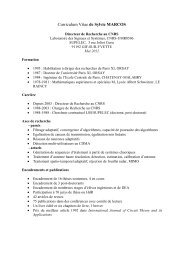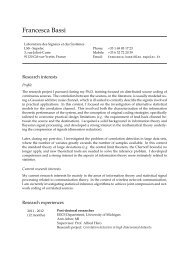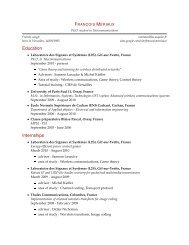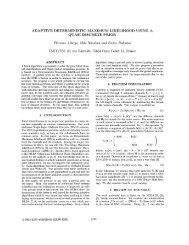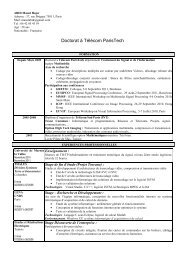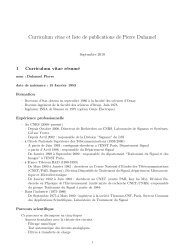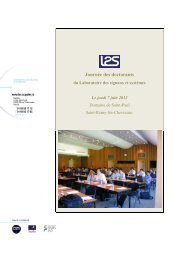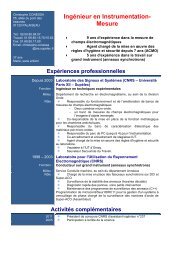THÈSE DE DOCTORAT Ecole Doctorale « Sciences et ...
THÈSE DE DOCTORAT Ecole Doctorale « Sciences et ...
THÈSE DE DOCTORAT Ecole Doctorale « Sciences et ...
You also want an ePaper? Increase the reach of your titles
YUMPU automatically turns print PDFs into web optimized ePapers that Google loves.
ensured. The work of [12] has been extended to other<br />
classes of systems. In [21], observers for a MIMO class<br />
of state affine systems where the dynamical matrix depends<br />
on the input, have been designed when the inputs<br />
are regularly persistent. In [3], a similar m<strong>et</strong>hod has<br />
been used for a larger class of systems and applied to<br />
the observation of emulsion copolymerization process.<br />
The observation of a class of systems with output injection<br />
has been treated in [22]. Recently, in [15], a high<br />
gain continuous-discr<strong>et</strong>e observer has been developed<br />
but using constant observation gains.<br />
On the other hand, it appears that for a number of<br />
physical processes some param<strong>et</strong>ers may not be known,<br />
that makes existing results on continuous-discr<strong>et</strong>e time<br />
observers non-applicable. In this paper, the observation<br />
of the class of systems studied in [21] is extended<br />
to the adaptive case. Early developments of adaptive<br />
observers were made in [16,17] for linear systems. Adaptive<br />
observation of nonlinear systems have been investigated<br />
using different techniques that basically rely on<br />
linear adaptive algorithms, through coordinate change<br />
or output injection for instance, see [4,5,10,19,23]. In<br />
[24], a unified interpr<strong>et</strong>ation of the latter references has<br />
been proposed that emphasizes their characteristics.<br />
In [6], adaptive observation for state affine systems in<br />
continuous-time is discussed and the work [23] is extended.<br />
In this study, the approach developed in [6]<br />
on extended Kalman filters for a class of MIMO linear<br />
time-variant, is adapted to the sampled measures problem<br />
at the difference that, here, the estimation law is<br />
based on discr<strong>et</strong>e-time adaptive techniques.<br />
After having defined the class of systems considered<br />
and recalled the main objective, a class of adaptive<br />
continuous-discr<strong>et</strong>e observers is designed. Assuming<br />
some persistent excitation conditions and some hypotheses<br />
on the system output sampling times to hold,<br />
the global exponential stability of the observation error<br />
is proved. Finally, a simulation example is performed<br />
which illustrates the design procedure.<br />
2 Nomenclature<br />
First some mathematical notation is introduced. L<strong>et</strong><br />
R def<br />
def<br />
= (−∞, ∞), R + = (0, ∞), R + def<br />
0 = [0, ∞) and defined<br />
the Euclidean norm ‖·‖. For p, q, n, m ∈ N, R p×q<br />
represents the s<strong>et</strong> of real matrices of order p × q and<br />
I p ∈ R p×p stands for the identity matrix of order p×p. If<br />
X ⊂ R p×q and Y ⊂ R n×m , C(X, Y) denotes the space of<br />
all continuous functions mapping X → Y. If P ∈ R p×p ,<br />
P > 0 means that P is positive definite. The notation<br />
‖P ‖, for P ∈ R p×q , represents the L 2 -norm of P. For<br />
A : R → R p×q and t ∈ R, the notation A(t − ) denotes<br />
the left limit of A at instant t, if it exists. In all this<br />
study, the initial time is called t 0 ∈ R.<br />
3 Problem statement<br />
The following class of systems is considered, for t ∈<br />
[t k , t k+1 ), k ≥ 0,<br />
ẋ(t) = A(u)x(t) + b(u) + φ(u)θ,<br />
y(t k ) = Cx(t k ),<br />
(1)<br />
where x ∈ R n is the instantaneous state vector, u ∈ D ⊂<br />
R m the input vector ( D is compact), y ∈ R p is the output<br />
vector, θ ∈ R l is a vector of unknown constant param<strong>et</strong>ers,<br />
A ∈ C(R m , R n×n ), b ∈ C(R m , R n ), C ∈ R p×n ,<br />
φ ∈ C(R m , R n×l ) are known, with n, m, p, l ∈ N and<br />
x 0 = x(t 0 ). The notation (t k ) k≥0 represents a strictly<br />
increasing sequence such that lim k→∞ t k = ∞ that models<br />
the sampling times. The maximum sampling step is<br />
denoted τ = max k≥0 (τ k ), where τ k = t k+1 − t k .<br />
Note that the class of systems (1) contains systems of<br />
the form, for k ≥ 0,<br />
ẋ(t) = A(t, u)x(t) + b(t, u) + φ(t, u)θ, t ∈ [t k , t k+1 ),<br />
y(t k ) = Cx(t k ), t = t k+1 ,<br />
(2)<br />
since the dependence on u can be considered like a time<br />
dependence.<br />
The main objective of this paper is to synthesize a global<br />
exponential adaptive observer, as defined in Section 4.3,<br />
for system (1).<br />
4 Observer design and stability study<br />
4.1 Observation structure<br />
The proposed observer can be viewed as an extension to<br />
the adaptive case of the structure developed in [21]. An<br />
auxiliary variable, λ, which plays a key role in the convergence<br />
of param<strong>et</strong>ers estimator, is notably introduced<br />
like in [23,6].<br />
For k ≥ 0, t ∈ [t k , t k+1 ),<br />
˙ˆx(t) = A(u)ˆx(t) + b(u) + φ(u)ˆθ(t k ),<br />
Ṡ(t) = −A(u) T S(t) − S(t)A(u) − µS(t),<br />
for t = t k+1 ,<br />
˙λ(t) = A(u)λ(t) + φ(u),<br />
˙ˆθ(t) = 0,<br />
ˆx(t k+1 ) = ˆx(t − k+1 ) + (λ(t k+1 )∆(t k+1 )<br />
+ρτ k S −1 (t k+1 )C T )(y(t k+1 ) − Cˆx(t − k+1 )),<br />
(3a)<br />
(3b)<br />
(3c)<br />
(3d)<br />
(4a)<br />
2



